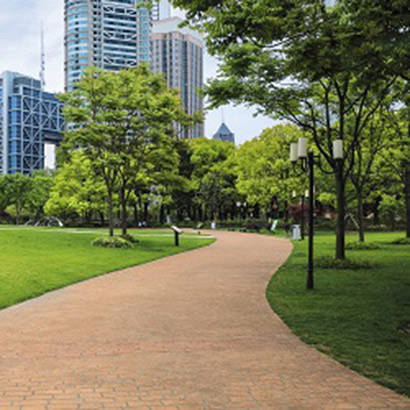
In the midst of Boston’s bustling, diverse Jamaica Plain neighborhood sits a former quarry site known as Nira Rock. Though Jamaica Plain contains several Olmsted “Emerald Necklace” parks, Nira Rock is unlike any of those manicured green spaces. With its 40-foot puddingstone outcropping and steep slopes, it is a craggy, untamed place. Surrounding the sheer rock face are shrubby woodlands, a hilly meadow, and an orchard. Nira Rock is an urban wild.
Boston has long recognized the importance of not only protecting such spaces—but of planning for and preserving them in ways much different than caring for traditional urban parkland. The city’s Urban Wilds Initiative gives the parks department the main responsibility for overseeing the acquisition and conservation of natural areas. And Nira Rock, a trail-accessed parcel of land the city acquired, was, as Boston mayor Thomas Menino states, “a perfect fit” for the Great American Trails grant. The existing trail linked Nira Rock to the bordering Arcola Street via a steep, granite and puddingstone stairway—and that entrance desperately needed improvements for public safety and accessibility.
The city received a Great American Trails grant from the Darden Foundation at about the same time a local couple also selected the site for their own philanthropic initiative. Newlyweds Nathaniel and Melanie Stinnett, who asked wedding guests to contribute to a fund to benefit Nira Rock rather than purchase wedding gifts, ended up donating more than $20,000.
Paul Sutton, who manages Boston’s Urban Wilds Initiative, says one of the most rewarding aspects of natural area and trails projects is how far such donations can go in opening up a natural area to the public.
“With the grants we were able to put in a whole new trail head, a trail link so it is a complete circuit through the entire site now. It is a good case study for what you can do with this amount of money…to make [an urban wild] accessible, attractive, and more usable for an urban public that really is sometimes detached from these kinds of areas.”
The grant money not only improved trail infrastructure and entrance staircase—it also allowed for the installation of native plants and landscaping and a handicapped-accessible seating area.
The outcome, Sutton adds, is a natural playground where rock-climbing and exploration take center stage, rather than big-ticket manufactured play equipment. It is, because of its natural beauty and variegated terrain, a site augmented and made more accessible at a relatively low cost.
The two-acre wild is, in fact, the only public, natural area available to this densely populated neighborhood with few yards. And it sits in a central spot, abutting a hospital, school, playground, and community garden. Maureen McQuillen, Events and Development Director for Boston Parks and Recreation, shares a story of a shy, nine-year-old girl who came to the grand opening ceremony for Nira Rock: “She lived four houses away, and she was just thrilled to be introduced to the park. She hadn’t known it was there, and then her eyes were suddenly opened to this place.”
The local LongHorn Steakhouse catered the grand opening of the Arcola Street entrance to Nira Rock—providing not only generous samplings of their food but decorated pumpkins and other seasonal touches.
With the renovated trail in place and the site improved, the parks department expects to see heavy year-round use from local families, rock-climbers, school groups, and nature-lovers of all ages. And park programs will include an array of interactive programs at the site combining nature with science and the arts.

